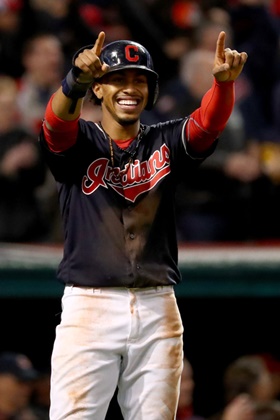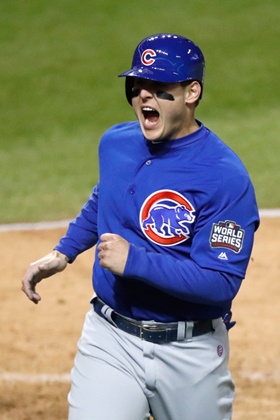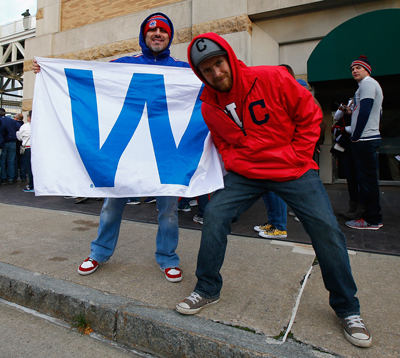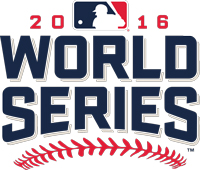 |
|
 |
The Indians-Cubs World Series matchup provides an “exclamation point to the season.”
Photo by: GETTY IMAGES (2) |
An unusual World Series matchup has given Major League Baseball a shot in the arm right when it needed it.
A mixed regular season saw a slight attendance drop, a setback on pace of play, and national ratings trending lower. That led into a sluggish postseason that featured several noncompetitive series, and the traditional concern over the state of the game and whether its coast-to-coast appeal has retreated to regional strongholds.
But the Chicago Cubs and Cleveland Indians, two Series-starved franchises seeking championship glory, have flipped the script, as buzz and early numbers prove.
“This has certainly been something of an exclamation point” to the season, said Will Bortz, director of partnerships and sponsorships for Taco Bell, which conducted its popular “Steal a Base, Steal a Taco” World Series activation for the fifth time. “Baseball is one of those sports that still has great storytelling, and this Series has been a tremendous story.”
Start with Fox Sports, where television ratings were on track to be the highest since 2009 and ad rates were up 4 percent from last year to an estimated $565,000 per 30-second spot. The network reported that a number of brands participated in the baseball broadcast for the first time.
In the local markets, ticket resale prices were the highest in baseball history, surging past $4,000 a ticket for games at Wrigley Field in Chicago. Talk of Chicago and Cleveland filled watercooler conversations across the country and led morning and evening news shows previously dominated by the upcoming U.S. presidential election. It almost felt as if baseball had eclipsed the NFL in early November.
Such energy stands in contrast to the regular season, when attendance fell 0.8 percent, increased pace-of-play efforts slid backward with a four-minute increase in average game time, and regular-season ratings fell on numerous national and local networks. Postseason ratings before the World Series lagged behind last year by 8 percent, even after Fox Sports 1 posted the best week of its short history during the NL Championship Series.
 |
Photo by: GETTY IMAGES
|
“These are two great teams and two great cities, and it’s hard to ask for much more than what we’ve got here.”
BOB BOWMAN
MLB PRESIDENT OF BUSINESS AND MEDIA
But MLB Commissioner Rob Manfred didn’t look like a man concerned by some of the falling indices and, like many close to the game, chose to focus on the sport’s deep local and regional entrenchment.
“Interest in the game remains really strong. Many of our teams have the top-rated programming in their respective markets,” Manfred said. “And when you look at this [World Series] matchup, it’s something that has significant interest both locally and nationally.”
All acknowledge the game is fundamentally healthy with total league revenue pushing toward $10 billion, and MLB earlier this summer striking a groundbreaking $1 billion deal with Disney for a third of BAM Tech. A transfer this summer of majority control of the Seattle Mariners to John Stanton valued the franchise at $1.4 billion, representing the second-highest transaction value for a baseball team.
But the powerhouse World Series comes as the league and MLB Players Association remain engaged in collective bargaining on a new labor deal that likely will bring substantial changes on how teams acquire and groom amateur talent. The current pact expires Dec. 1, and many are anxious to learn what the new rules of engagement will be. This round of bargaining has been focused less on business issues, and more around the product on the field, and how best to present it in the future. But the next agreement, assuming one arrives, will still affect how teams build their rosters and go to market.
“Competitive balance is working, and this Series matchup is something really exciting for all of us involved in the game. But each year, the economics become a little more important,” said Oakland A’s owner Lew Wolff, among those wanting to ensure that MLB clubs at all economic levels still will have a chance to compete for a World Series title.
Baseball’s audience, too, is changing as it becomes more female and the league continues to seek out younger audiences. The sport overall underindexes slightly among women compared with the general U.S. population, with a 35 percent base of avid female fans, according to industry data. But some in the game have begun to see the gap close.
“We’re definitely seeing shifts in our facilities, the biggest being the increase in females at the ballparks,” said Tom Funk, executive vice president and chief operating officer for Levy Restaurants, which oversees food and beverage operations at seven MLB ballparks, including Wrigley Field. “We’ve needed to factor that in [and] adapt our product mix.”
Among the changes at Levy’s MLB ballparks is a decrease in domestic beer sales, increases in wine, spirits and craft beer, and more female-oriented merchandise.
MLB also continues to be an innovator in digital media and technology, and its internal Live Digital Data Ratings found record levels of consumption of the league’s popular online and mobile products during the earlier rounds of the playoffs.
 |
MLB's audience is becoming more female, as the league continues to seek younger fans.
Photo by: GETTY IMAGES
|
That digital strength is encouraging for many brands, who also stress the local appeal of baseball.
“When you look at baseball’s strengths, it has a digitally and socially engaged audience that obviously ties very well into who we are, but it’s also incredibly strong at the local level,” said Meredith Starkey, T-Mobile senior director of sponsorships, entertainment and events. The wireless carrier has been using the MLB playoffs to conduct an “Unlimited Baseball” marketing campaign that ties into its new T-Mobile One unlimited data plans. The company is also a World Series presenting sponsor.
“Those are areas where we’re continuing to get deeper and deeper into with baseball, and areas that go well beyond a basic national TV rating,” Starkey said.
But those younger-skewing digital connections to baseball contrast the sport’s older and more male core television audience that frequently averages more than 50 years old.
“The World Series is still a lot about men aged 18-49 and 25-54,” said Michael Law, executive vice president and managing director of video investment for Amplifi US. The media agency represents several brands with ties to MLB, including MasterCard.
“Postseason baseball is still a great platform to reach male audiences, and brands are looking for big audiences in a period of fragmentation, which baseball has. It still probably skews a little older,” Law said.
| Gender |
| All fans |
| 56% |
44% |
| male |
female |
| Avid fans |
| 65% |
35% |
| male |
female |
| General U.S. population |
| 49% |
51% |
| male |
female |
| Average age |
| All fans |
| 45.3 years |
| Avid fans |
| 44.5 years |
| General U.S. population |
| 46 years |
Source: Nielsen Sports Sponsorlink data, 2016 year-to-date. U.S. market only, ages 18+
For the game’s media partners, the World Series represented a welcome boost to their own businesses. Despite numbers that were down from previous years for its division and championship series, Fox Sports ran national ads touting how live playoff game coverage was driving its Fox Sports 1 to record viewership. A long World Series that returns to Progressive Field in Cleveland for Games 6 and 7 Tuesday and Wednesday could move ratings beyond the current comparisons to the 2009 New York-Philadelphia matchup, and toward more popular ones such as 2004 (Boston-St. Louis) and 2001 (New York Yankees-Arizona).
Throughout the postseason, Fox Sports executives have been preaching patience, hoping for long series that would allow momentum to build.
“This is the ultimate wait-and-see event,” said Mike Mulvihill, Fox Sports executive vice president of research, league operations and strategy. “With October baseball, you really have to let it all play out and not get too far ahead of yourself.”
While the game remains healthy at the local and regional level, the issue of national star appeal remains. MLB Players Association Executive Director Tony Clark earlier this year said that “other leagues nationally move their players out in the forefront” more than baseball.
The everyday nature of baseball makes promotion of stars a complicated matter because of the demanding playing schedule.
Among the issues the league and union are discussing at the bargaining table is seeking out ways to tweak the schedule and create more off days for players, not only providing more rest and recovery for players, but theoretically creating more room for marketing.
But where the game may lack household names, it certainly doesn’t lack for talent. Last week, hall of famer Hank Aaron gushed about the recent influx of young talent in the sport including Cubs third baseman Kris Bryant, one of this year’s Aaron Award winners. “I told Willie Mays about three weeks ago, ‘You and I would probably be in the minor leagues compared to these guys,’” Aaron said. “‘We couldn’t keep up with them the way they’re playing.’”
Bob Bowman, MLB president of business and media, said the Cubs and Indians represented an almost perfect showcase of teams filled with young homegrown talent.
“These are two great teams and two great cities,” Bowman said, “and it’s hard to ask for much more than what we’ve got here.”
One thing baseball and its partners can ask for: momentum from a historic Fall Classic that, along with a new CBA, carries into next season.








